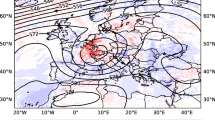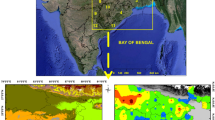Abstract
The analysis of rainfall frequency is an important step in hydrology and water resources engineering. However, a lack of measuring stations, short duration of statistical periods, and unreliable outliers are among the most important problems when designing hydrology projects. In this study, regional rainfall analysis based on L-moments was used to overcome these problems in the Eastern Black Sea Basin (EBSB) of Turkey. The L-moments technique was applied at all stages of the regional analysis, including determining homogeneous regions, in addition to fitting and estimating parameters from appropriate distribution functions in each homogeneous region. We studied annual maximum rainfall height values of various durations (5 min to 24 h) from seven rain gauge stations located in the EBSB in Turkey, which have gauging periods of 39 to 70 years. Homogeneity of the region was evaluated by using L-moments. The goodness-of-fit criterion for each distribution was defined as the ZDIST statistics, depending on various distributions, including generalized logistic (GLO), generalized extreme value (GEV), generalized normal (GNO), Pearson type 3 (PE3), and generalized Pareto (GPA). GLO and GEV determined the best distributions for short (5 to 30 min) and long (1 to 24 h) period data, respectively. Based on the distribution functions, the governing equations were extracted for calculation of intensities of 2, 5, 25, 50, 100, 250, and 500 years return periods (T). Subsequently, the T values for different rainfall intensities were estimated using data quantifying maximum amount of rainfall at different times. Using these T values, duration, altitude, latitude, and longitude values were used as independent variables in a regression model of the data. The determination coefficient (R 2) value indicated that the model yields suitable results for the regional relationship of intensity–duration–frequency (IDF), which is necessary for the design of hydraulic structures in small and medium sized catchments.




Similar content being viewed by others
References
Acar R, Celik S, Senocak S (2008) Rainfall intensity-duration-frequency (IDF) model using artificial neural network approach. J Sci Ind Res 67:198–202
Alila Y (2000) Regional rainfall depth-duration-frequency equations for Canada. Water Resour Res 36:7 1767–1778
Anilan T, Yuksek O, Kankal M (2016) Flood frequency analysis of Eastern Black Sea Basin based on L-moments. Teknik Dergi 132(27):7403–7427
Atiem A, Harmancıoglu NB (2006) Assessment of regional floods using L-moments approach: the case of the River Nile. Water Resour Manag 20:723–747
Awadallah AG (2016) Regional intensity-duration-frequency curves for Jeddah region, Saudi Arabia, using ordinary and L-moments approaches. J. Flood Risk Manage. 8(3):195–207
Aydoğan D, Kankal M, Önsoy H (2016) Regional flood frequency analysis for Çoruh Basin of Turkey with L-moments approach. J Flood Risk Manage 9:69–86
Bayazıt M, Avcı I (1997) Water resources of Turkey: potential, planning, development and management. Int. J. Water Resour Dev 13:443–452
Bell FC (1969) Generalized rainfall–duration–frequency relationship. J Hydraul Eng 95:311–327
Bernard MM (1932) Formulas for rainfall intensities of long durations. Trans Am Soc Civil Eng 96:592–624
Chen CL (1983) Rainfall intensity–duration–frequency formulas. J Hydraul Eng 109:1603–1621
Chowdhary H (2009) Discussion of IDF curves using the Frank Archemedean Copula. J Hydraul Eng 12:6 651–662
Dawson CW, Abrahart RJ, Shamseldin AY, Wilby RL (2006) Flood estimation at ungauged sites using artificial neural networks. J Hydrol 319:391–409
Di Balldassarre G, Castellarin A, Brath A (2006) Relationships between statistics of rainfall extremes and mean annual precipitation: an application for design-storm estimation in northern Central Italy. Hydrol Earth Sys Sci 10:589–601
DSI (2010) (General Directorate of State Hydraulic Works). Official agenda. Ankara, Turkey
Hassan BGH, Ping F (2012) Regional rainfall frequency analysis for the Luanhe Basin by using L-moments and cluster techniques. APCEE. Procedia 1:126–135
Hosking JRM (1990) L-moments: analysis and estimation of distributions using linear combinations of order statistics. J R Stat Soc B 52:105–124
Hosking JRM, Wallis JR (1993) Some statistics useful in regional frequency analysis. Water Resour Res 29:271–281
Hosking JRM, Wallis JR (1997) Regional frequency analysis: an approach based on L-moments. Cambridge University Press, Cambridge, UK England
Hosking JRM, Wallis RJ, Wood EF (1985) Estimation of the generalized extreme value distribution by the method of probability weighted moments. Technometrics 27:251–261
Karahan H, Ayvaz MT, Gurarslan G (2008) Determination of intensity-duration-frequency relationship by genetic algorithm: case study of GAP. Teknik Dergi 19(2):4393–4407
Karahan H, Ceylan H, Ayvaz T (2007) Predicting rainfall intensity using a genetic algorithm approach. Hydrol Process:470–475
Kumar R, Chatterjee C (2005) Regional flood frequency analysis using L-moments for North Brahmaputra region of India. J Hydrol Eng 10:1–7
Lin FJ (2008) Solving multicollinearity in the process of fitting regression model using the nested estimate procedure. Qual Quantity 42(3):417–426
Liu RX, Kuang J, Gong Q, Hou XL (2003) Principal component regression analysis with SPSS. Comput Methods Prog Biomed 71(2):141–147
Madsen E (2002) Regional estimation of rainfall intensity-duration-frequency curves using generalized least squares regression of partial duration series statistics. Water Resour Res 38:11 12-39
Mekanik F, Imteaz MA, Gato-Trinidad S, Elmahdi A (2013) Multiple regression and artificial neural network for long-term rainfall forecasting using large scale climate modes. J Hydro 503:11–21
Nhat LM, Tachikawa Y, Takara K (2006) Establishment of intensity–duration–frequency curves for precipitation in Themonsoon area of Vietnam. Annuals of Disas Prev Res Inst,Kyoto Univ 49 B:93–103
Nobert J, Mugo M, Gadain H (2014) Estimation of design floods in ungauged catchments using a regional index flood method. Phys Chem Earth A/B/C 67:4–11
Noto LV, Logggia GL (2009) Use of L-moments approach for regional frequency analysis in Sicily, Italy. Water Resour Manag 23:2207–2229
Qi WW, Zhang BP, Yao YH, Zhao F, Zhang S, He WH (2016) A topographical model for precipitation pattern in the Tibetan plateau. J Mt Sci 13(5):763–773
Seckin N, Haktanir T, Yurtal R (2011) Flood frequency analysis of Turkey using L-moments method. Hydrol Process 25:3499–3505
Sherman LK (1932) Streamflow from rainfall by the unit hydrograph method. Eng News Rec 108:501–505
Uzlu E, Akpınar A, Kömürcü Mİ (2011) Restructuring of Turkey’s electricity market and the share of hydropower energy: the case of Eastern Black Sea Basin. Renew Energ 36:676–688
Yang T, Shao Q, Hao ZC, Chen X, Zhang Z, CY X, Sun L (2010a) Regional frequency analysis and spatio-temporal pattern characterization of rainfall extremes in Pearl River basin, China. J Hydrol 380:386–405
Yang T, Xu C, Shao Q (2010b) Regional flood frequency and spatial patterns analysis in the Pearl River Delta region using L-moments approach. Stoch Environ Res Risk Assess 24:165–182
Yuksek O, Kankal M, Ucuncu O (2013) Assessment of big floods in the eastern Black Sea basin of Turkey. Environ Monit Assess 185:797–814
Zakaria ZA, Shabri A (2013) Regional frequency analysis of extreme rainfalls using partial L moments method. Theor Appl Climatol 113:83–94
Zaman MA, Rahman A, Haddad K (2012) Regional flood frequency analysis in arid regions: a case study for Australia. J Hydrol 475:74–83
Author information
Authors and Affiliations
Corresponding author
Rights and permissions
About this article
Cite this article
Ghiaei, F., Kankal, M., Anilan, T. et al. Regional intensity–duration–frequency analysis in the Eastern Black Sea Basin, Turkey, by using L-moments and regression analysis. Theor Appl Climatol 131, 245–257 (2018). https://doi.org/10.1007/s00704-016-1953-0
Received:
Accepted:
Published:
Issue Date:
DOI: https://doi.org/10.1007/s00704-016-1953-0




